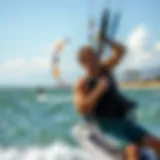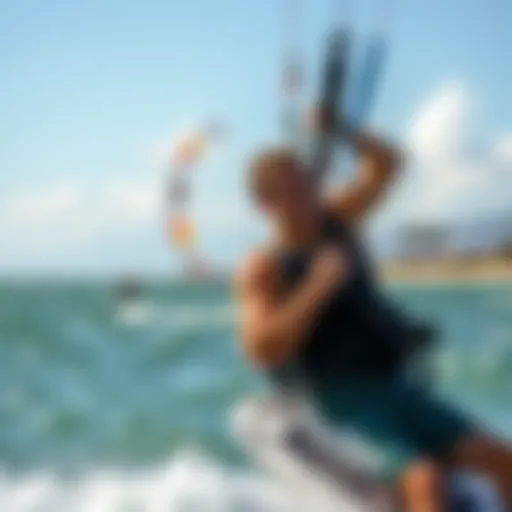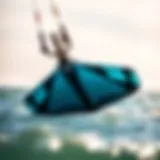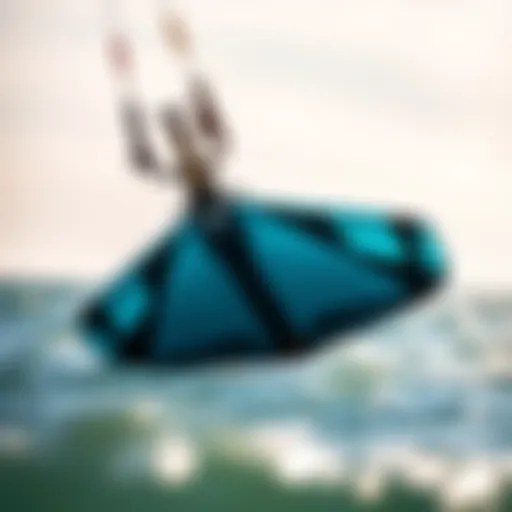Exploring Foil Boards: Insights for Kiteboarding Enthusiasts
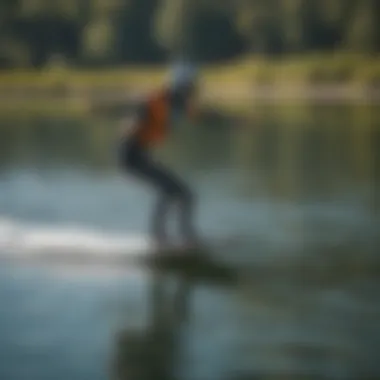

Intro
The world of kiteboarding has seen a remarkable transformation in recent years, particularly with the emergence of foil boards. No longer just a niche product for serious enthusiasts, these boards have found their way into the hands of kiteboarding aficionados of various skill levels. The allure of gliding above water, feeling the wind tickle your face, and the thrill of mastering the nuances of a foil board are part of an exciting journey many want to embark upon.
Foil boards, with their unique dart-like shape and a submerged wing, enable riders to skim over the water’s surface in a way that traditional boards simply can’t match. This article takes a closer look at the intricacies of foil boards, presenting opportunities for both newcomers and seasoned riders alike. We will also dissect key market trends, essential tips, and the must-consider factors when selecting gear.
The Buzz in the Community
Kiteboarding forums, Facebook groups, and Reddit threads are abuzz with discussions surrounding foil boards. Enthusiasts share their experiences, recommend gear, and swap tips, creating a vibrant community fueled by a shared passion for the sport. The excitement is palpable, and as new technology emerges, many are eager to dive into this new slice of kiteboarding bliss.
It's vital to stay abreast of the developments in this gear-heavy sport. With varied foil board designs and features flooding the market, making informed decisions is key. Whether you aim to cut through waves like a knife through butter or simply enjoy a leisurely glide, understanding what foil boards offer becomes paramount.
As we navigate through the highlights of techniques, gear considerations, and practical riding tips, this guide seeks to be a beacon for both kiteboarding newbies and seasoned riders. Embracing the challenges, honing your skills, and unlocking the full potential of foil boarding can transform an already thrilling sport into something genuinely exhilarating.
Understanding Foil Boards
Understanding foil boards is crucial for anyone looking to ride the waves while harnessing the power of wind and water. They represent a significant shift in the way kiteboarding is approached, opening up new possibilities for enthusiasts and competitors alike. Unlike traditional boards, which skim across the surface, foil boards allow riders to lift above the water and glide smoothly, creating a unique riding experience.
The mechanics behind foil boards provide a fascinating blend of aerodynamics and hydrodynamics. A foil board consists of a board attached to a hydrofoil, which is submerged beneath the water. As the rider speeds up, the hydrofoil generates lift, raising the board above the water's surface. This not only reduces drag but also enhances speed and maneuverability, making for a thrilling ride.
Definition and Mechanics of Foil Boards
To grasp the essence of foil boards, it’s important to get familiar with their components and how they function. Foil boards are specially designed with a mast, wings, and a fuselage, which all play key roles in generating lift. The wings are crucial as they create a pressure differential when water flows over and under them.
When you’re on a foil board, the experience feels radically different. You ascend above the water, creating a new sense of freedom. This ride facilitates sharp turns, quick accelerations, and the ability to navigate diverse water conditions with ease.
Comparison with Traditional Boards
Comparing foil boards to traditional boards reveals a number of key differences that cater to various riding preferences.
Performance differences
When talking about performance, foil boards offer a whole new dimension. The biggest difference is the ability to ride over flat water without the same level of drag faced by traditional boards. This performance characteristic allows riders to maintain higher speeds with less effort.
Foil boards excel in lighter winds, often enabling seasoned kiteboarders to catch waves and glide smoothly even when the conditions seem less than ideal. However, it’s worth noting that the learning curve can be steep. The intricacies of balance and control require considerable practice and skill.
Usage contexts
The usage contexts for foil boards sets them apart as well. They shine when it comes to racing or conquering longer distances and often provide more versatility in location. Whether it’s riding in shallow waters or enjoying open ocean conditions, foil boards aren’t as limited as traditional boards.
For instance, a rider can successfully embark on a long-distance trip from one area to another with little more than a breeze. However, they might struggle in crowded spots due to the shifting nature of the foil, which could lead to inexperienced riders having difficulty staying upright.
Advantages and challenges
Foil boards definitely have their advantages, especially in varied wind conditions. They allow riders to explore options beyond conventional kiteboarding. The ability to ride in lighter winds is a significant draw, encouraging those in regions with minimal windy days to participate in the sport.
However, challenges exist too. Stability can be an issue, particularly for beginners. The mechanics of foil boards require understanding how to control the lift and maintain balance, which some might find daunting. Over time, though, as one gains proficiency, they often find it rewarding, creating a path for advanced tricks that traditional boards limit.
"Foiling feels like flying over the water; it’s a different kind of riding that calls for practice but offers unparalleled exhilaration once mastered."
Market Trends in Foil Boards
Keeping an eye on the market trends surrounding foil boards is not just a pass-time; for those deeply invested in the kiteboarding world, it's essential. The growth of foil boards represents a significant shift in the dynamics of recreational sports. Understanding where the market is going allows kiteboarding enthusiasts to make informed choices when purchasing gear. This section dives into two key aspects: the increasing popularity of foil boards and the technological innovations driving this trend.
Emerging Popularity Over Recent Years
In recent years, foil boards have surged in popularity, transitioning from niche products to mainstream gear within the kiteboarding community. Several factors contribute to this noteworthy trend.
First off, the thrill of flying above the water has captivated many. Foil boarding offers a unique experience, enabling riders to skip over the waves, thus providing a sense of freedom and exhilaration. With social media showcasing breathtaking aerial footage, newcomers flock towards this exciting experience. It's hard to resist the allure of what looks like floating on air.
Moreover, as more people discover foil boarding, more manufacturers are entering the market, resulting in enhanced product availability. Capacity for personal advancement and tailored riding experiences becomes accessible to both inexperienced and seasoned riders. This burgeoning interest has not gone unnoticed by retailers, with many shops dedicating entire sections of their stores to foil boards.
"The rise of foil boards symbolizes an evolution in kiteboarding—one that embraces innovation, excitement, and a growing community of enthusiasts."
Technological Innovations
The rising trend of foil boards can largely be attributed to cutting-edge technological advancements. There's a variety of innovations in materials used, design modifications, and performance specifications that distinguish modern foil boards from those of yesteryear.
Materials used


The materials shaping today’s foil boards tend to centre around strength and weight. Manufacturers often rely on lightweight carbon fiber and advanced composites, allowing boards to achieve a delicate balance between durability and ease of maneuver. Carbon fiber, for instance, is known for being lightweight yet rigid, giving it the edge when speed and agility are paramount. This has become a go-to material due to its ability to withstand harsh water conditions, giving riders confidence in their gear.
This lightness contributes directly to the foil board's performance. It enhances responsiveness and maneuverability, making it a sought-after feature among both beginners wanting an easier learning curve and experienced riders aiming for advanced tricks.
Design advancements
In the realm of design, continual improvements are noticeable. Manufacturers have been quick to adapt shapes, sizes, and features to enhance rider performance. This includes the widening of boards and the adjustment of foil positions, helping with improved stability during varied conditions. Custom designs appeal to a broader audience, ensuring there’s something for everyone, regardless of their riding style.
The introduction of adjustable foils has revolutionized how riders engage with their gear. Riders can tailor their setups according to personal preference, skill level, or environmental conditions, making it increasingly popular among enthusiasts.
Performance enhancements
Performance enhancements mark one of the most pivotal evolutions in foil board technology. Modern boards incorporate hydrodynamic designs that reduce drag and improve lift, enabling smoother rides. Enhanced performance is particularly advantageous in low-wind scenarios, where kiteboarding might otherwise prove cumbersome.
Performance frontiers have expanded with integration of scientific research into aerodynamics, resulting in boards that not only perform better but also foster rider skills in learning advanced maneuvers. They truly reflect the catchphrase, "One board, countless possibilities" reflecting the growing diversity in riding experiences and aspirations.
In summary, the combination of increasing popularity and technological innovation plays a tremendous role in the evolution of foil boards, shaping future riders' experiences. It seems fair to say that the kiteboarding landscape has never been more dynamic.
Key Features to Consider When Buying
When delving into the realm of foil boards, understanding key features before making a purchase can be a game changer. Each element significantly affects how the board performs, how enjoyable your ride is, and how suited it is to your skill level and riding style. Therefore, taking time to assess these features is crucial for anyone looking to invest in this increasingly popular equipment.
Hull Shape and Size
The hull shape and size are foundational aspects that impact hydrodynamics and the overall riding experience. Different hull shapes serve various purposes. For instance, a wide hull provides more stability, making it ideal for beginners who are still mastering balance. Meanwhile, a narrow hull can enhance speed and maneuverability, but it might require a more experienced rider to fully exploit its potential.
Adding to this, the size of the hull affects how the board interacts with water. Smaller boards are generally lighter and easier to control in swift maneuvers, but they may lack the buoyancy needed for smooth rides in choppier waters. As every rider has different preferences, it is essential to choose a hull shape and size that aligns with your specific needs and comfort level.
Weight and Material Composition
The weight of a foil board often correlates with its material composition. Boards made from high-quality materials like carbon fiber are typically lighter and more durable, offering a performance advantage. Conversely, composite materials may be heavier but can provide greater stability and are often more affordable.
When selecting your foil board, consider how weight impacts your riding style. Lighter boards are generally easier to maneuver and can aid in achieving faster speeds. However, heavier boards might be favorable for learners, as they can create greater stability in the water. Always think about the interplay between weight and material—it’s about striking the right balance for your skill level and riding preferences.
Foil Design and Configuration
The design and configuration of the foil itself can dramatically impact performance.
Front and Rear Foil Choices
The choice of front and rear foils is vital to how a board handles different conditions. For instance, a larger front foil offers more lift, making it easier for beginners to get off the water and maintain that lift in various conditions. On the other hand, smaller foils can allow for a more agile riding style, which experienced riders often prefer to execute high-speed turns and tricks.
Key characteristics to consider include surface area and aspect ratio. A higher surface area typically means increased stability but may come at the cost of maneuverability. In contrast, a lower surface area might provide more agility, which can be essential for those looking to engage in advanced tricks. Each option carries its own set of advantages and disadvantages that should align with your ambitions on the water.
Stability and Maneuverability Impacts
Stability and maneuverability are two sides of the same coin. While stability is crucial for a smooth riding experience, particularly for beginners, maneuverability can enhance the enjoyment and challenge for experienced riders. A board designed for maximum stability often has a wider stance and larger front wing which helps with control at slower speeds.
Conversely, for those looking to perform tricks or swift maneuvers, a narrower design with a refined foil configuration is typically preferred. Finding a balance between these two characteristics will depend on your skill level and intended use. To summarize:
- Stability is key for beginners and ensures a more forgiving ride.
- Maneuverability enhances the experience for intermediates and advanced riders seeking adrenaline and challenge.
With these aspects in mind, navigating the considerable choices available in foil boards can become a more straightforward task. By understanding the hull shape, material composition, and foil design, you're better positioned to select a board that fits your riding goals and enhances your experience on the water.
Where to Find Foil Boards for Sale
Finding the right foil board isn’t just about going to the store and snatching up whatever catches your eye. It’s about navigating a marketplace full of options, understanding what you need, and knowing where to look. This section highlights various avenues to explore for purchasing foil boards, considering the advantages and pitfalls of each. With kiteboarding gaining traction, being well-informed can enhance your buying experience and ultimately your time on the water.
Local Kiteboarding Shops and Retailers
Local kiteboarding shops serve as the heartbeat of any kiteboarding community. They not only offer foil boards, but they also provide an environment where enthusiasts gather, share tips, and build relationships. Shopping locally can be a big win; you get hands-on experience, expert advice, and the chance to physically inspect the boards.
For example, a local shop may host demonstration days, allowing prospective buyers to test the equipment before committing to a purchase. Additionally, knowledgeable staff can guide you through the nuances of different models, helping you to find a board that aligns with your skill level and riding goals.
That said, local shops might not always carry the latest models or wider selections available online, but fostering relationships with local businesses can lead to discounts or exclusive offers.
Online Marketplaces
Online shopping has changed the game when it comes to finding foil boards. The reach of the Internet opens up a treasure trove of options. However, it is crucial to discern which platforms best suit your needs.
Specialized kiteboarding websites
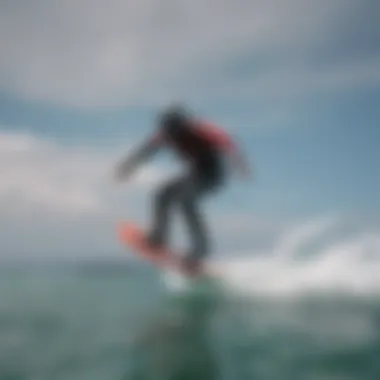

Specialized kiteboarding websites often cater specifically to the kiteboarding community. These platforms typically feature an extensive range of products, from new and trending foil boards to specialist gear that might be hard to find elsewhere.
One major advantage of these sites is the expertise they provide; many have reviews from other riders, which can shed light on performance aspects that might not be instantly apparent. Customers can also access detailed specifications, enhancing informed decision-making.
However, you might encounter downsides such as shipping costs or lack of customer service compared to brick-and-mortar stores. Beware of the potential wait for delivery, especially if you’re eager to hit the water.
General e-commerce platforms
On the flip side, general e-commerce platforms like Amazon or eBay also list an assortment of foil boards. A key characteristic of these sites is their sheer diversity—everything from top-of-the-line rigs to budget options can be found in one spot.
General platforms allow for easy price comparisons across different brands and models. You can often find reviews left by a broad user base, helping you gauge which product suits your riding style.
Nonetheless, navigating this sea of options can be overwhelming, given the lack of specialized knowledge regarding kiteboarding in comparison to niche sites. Plus, you may find that certain boards don’t come with the personalized customer service that local kiteboarding shops offer.
Second-Hand Foil Boards
Risks and benefits
Buying second-hand foil boards can be a mixed bag. The appeal here is clear: significant savings. Many kiteboarders trade up or change their gear frequently. A well-maintained board can offer a solid performance at a fraction of the cost. However, there are inherent risks involved. Sellers might not always disclose damage or wear, leading to unexpected costs after a purchase.
It’s essential to weigh the pros and cons carefully. An excellent bargain can quickly turn sour if the board is compromised. Evaluating the seller's reputation and condition of the equipment is paramount.
How to assess condition and value
Knowing how to assess the condition and value of second-hand equipment can save you a lot of headaches. Look for obvious signs of wear, like dents or scratches, as these can affect performance. Additionally, gauge if the components, like footstraps and fins, are still functional and intact.
A unique feature of assessing used boards lies in the market knowledge. Understanding how much a specific model typically sells for can help you negotiate a better price. However, take extra care—it’s easy to get taken for a ride if you aren’t savvy with the current market trends and conditions.
By exploring various buying avenues thoroughly—from local shops to online marketplaces and second-hand options—kiteboarders can find not just a foil board, but the right foil board, thus enhancing their water sports experience. Whether you're a novice looking to learn or a seasoned pro, being informed elevates the whole experience.
Pricing Considerations
When it comes to foil boards, understanding the pricing dynamics is crucial for both seasoned riders and newcomers alike. This knowledge not only helps in budgeting but also ensures that you get the best value for your investments. Different brands and models can heavily vary in cost, which can sometimes leave buyers feeling a bit confused. The goal here is to break it down and clarify why prices can range so widely, as well as what factors influence these costs. Successful investments are often governed by informed choices, and that's what this section aims to empower you with.
Range of Prices in the Market
Foil boards are not a one-size-fits-all product, and you'll find them priced anywhere from a few hundred to several thousand dollars. Generally speaking, an entry-level board may cost around $600 to $800, while high-performance models can exceed $2,500. These price points often reflect the quality of materials, brand reputation, and the technology employed in the board’s design.
Keep in mind that while lower-priced models may seem like a steal, they might not deliver the performance or durability you'd expect. Getting a foil board is not just about the upfront costs; consider the longer-term perspective, including what each price tier offers in performance, durability, and resale value.
Factors Influencing Cost
Brand Reputation
Brand reputation is closely tied to pricing in the foil board market. Well-established brands like Liquid Force or Slingshot tend to carry higher price tags, which can initially seem daunting. However, this premium often translates into trust in their performance and durability. Customers lean toward these brands not just for their name but for a history of reliability and pressure-tested designs. The unique aspect of established brands is their ability to maintain quality control, meaning you get what you pay for. But at the same time, lesser-known brands can offer competitive products at lower prices. Thus, weighing these options can prove beneficial to those looking to balance cost with reliability.
Technology and Materials
The materials and technology used in manufacturing foil boards play a significant role in their pricing. Boards made from advanced carbon fiber tend to be lighter and stronger but come at a premium. On the other hand, boards made of heavier materials like plastic or wood might be easier on the wallet but could compromise on performance. Each material presents its own benefits and drawbacks. Carbon fiber boards, for instance, allow for better maneuverability and speed but can lead to higher repair costs if damaged. Thus, understanding the benefits tied to the materials used can guide you in making a more informed purchasing decision.
Inclusivity of Accessories
Another important factor in the overall pricing of foil boards is the inclusion of accessories. Some brands bundle in essentials like foot straps, fins, and even carry bags within the purchase price. This can greatly affect the perceived value of a board. A board priced at $1,200 but comes with additional gear can turn out cheaper in the long run than a $800 board with no extras. In this case, the "included extras" offer practical advantages and might save you significant money later on. Your choice of accessories could determine not just comfort but also functionality while riding.
Important Note: Always read customer reviews and do some research before making that leap. It can be the difference between a fantastic board and an expensive regret.
As we navigate through the options available in the market, being cognizant of these pricing considerations can illuminate the often complex decision-making process involved in purchasing a foil board.
Usage and Riding Techniques
Understanding the various usage and riding techniques of foil boards is crucial for both novices and seasoned kiteboarders. This section sheds light on necessary skills that enhance overall performance on the water. Learning to ride with finesse not only boosts confidence, but also contributes to a more enjoyable experience. Through various riding techniques, athletes can unlock differing styles, allowing them to adapt to diverse conditions and personal preferences.
Basic Riding Skills for Beginners
For those just embarking on their foil boarding journey, mastering basic riding skills is essential. This lays a solid foundation for further advancement. Here are some key points to note:
- Stance and Balance: Maintaining a proper stance is vital. Beginners should aim for a hip-width stance, knees slightly bent, and weight evenly distributed. This keeps them upright and balanced, reducing the risk of falling.
- Board Control: Initially, it’s important to learn how to steer the board. Applying gentle pressure with your toes or heels allows for smooth turns. Effective board control helps in navigating through different water conditions.
- Use of the Kite: Understanding how to handle the kite influences speed and direction. Beginners can practice flying the kite on land before hitting the water. This builds familiarity and improves response time.
With dedication and practice, these basics will become second nature, creating a pathway to more advanced techniques.
Advanced Techniques for Experienced Riders
As riders become comfortable on their foil boards, they often seek to elevate their skills. Advanced techniques open doors to a more thrilling riding experience. Below are notable elements:
Learning to Control Speed and Direction
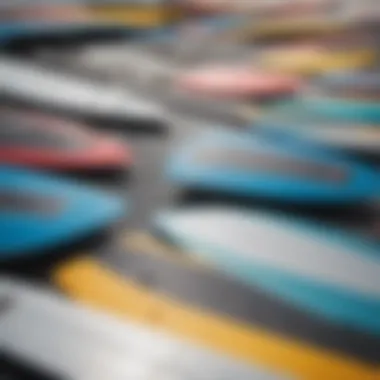

Mastering the art of controlling speed and direction is pivotal. This specific aspect helps riders adapt to various conditions, enhancing both safety and performance. Gradually refining this skill unlocks the ability to maintain a steady pace and change directions fluidly.
- Key Characteristic: Control over speed leads to smoother transitions and minimizes abrupt movements.
- Benefits: By fine-tuning speed management, riders can navigate more efficiently through challenging waves and rough patches of water. It also aids in maintaining optimal energy levels during long sessions.
- Unique Feature: Riders can experiment with varying speeds, leading to exhilarating experiences. However, this can be tricky to balance; too much speed may compromise control.
Performing Tricks and Maneuvers
As kiteboarders progress, performing tricks and maneuvers becomes an alluring goal. Tricks not only showcase a rider’s skill but also add an exciting element to the sport.
- Key Characteristic: The ability to execute tricks illustrates an advanced understanding of board dynamics and kite control.
- Benefits: Performing well-timed tricks draws admiration from peers and fosters a sense of achievement. This element is particularly popular among competitive riders.
- Unique Feature: Each trick has its mechanics and requires practice to master. While successful maneuvers can elevate one's game, the challenges associated with new tricks can lead to frustration if not approached with patience.
"Foil boarding is not just about riding; it's about connecting with the waves, mastering the elements, and pushing your limits every session."
Maintenance and Care of Foil Boards
Taking proper care of foil boards is not just a good idea; it’s essential for keeping them in tip-top shape. As any kiteboarder knows, these boards are investments and can take quite a beating, whether from the elements or from their own high-speed maneuvers. Prioritizing maintenance prolongs their lifespan and enhances performance. Regular upkeep can help prevent minor issues from escalating into costly repairs, ultimately saving you time, effort, and money down the line.
Cleaning and Storage Practices
One of the keystones of maintaining foil boards lies in how you clean them. Every time you come in from a session, a quick rinse with fresh water will wash away salt, sand, and debris that can corrode the board and foils. Using a soft cloth for thorough drying is advisable, particularly for the connections and parts that can rust.
Proper storage is equally important. Ideally, keep your foil board in a cool, dry place. Avoid leaving it in direct sunlight for extended periods, as UV rays can degrade materials over time. Using a padded bag or covering offers extra protection against scratches and impact during transport.
Storage Tips:
- Cool, Dark Location: Try to stash your board in a shaded area when not in use.
- Avoid Weight Pressure: Don’t stack heavy objects on top of it while stored away.
On a more practical note, take a moment to examine the board and foil for any signs of wear before each use. This adds another layer of protection against unexpected failures.
Repairing Common Issues
Identifying Damage
Recognizing damage is fundamental when it comes to foil board maintenance. Signs of wear and tear can range from superficial scratches to more serious structural damage that could impact performance. Small cracks in the hull or notable dents in the foil often signal that the board could use some TLC. Not spotting these problems right away might lead to more significant complications, or worse, injury during a ride.
Key characteristic of identifying damage includes being meticulous and proactive. Having a keen eye means you can catch issues early, which is generally less costly than dealing with a full-blown repair. The advantage here lies in ensuring safe rides and sustained performance. Propagating a habit like this might seem tedious, but find it more beneficial to be aware rather than reactive.
Replacement parts and services
When it comes to maintaining the integrity of your foil board, knowing when and how to replace parts is crucial. Over time, wear on components like stabilizers or mast foot connectors may necessitate a swap. Fortunately, many specialized shops offer these replacement parts and sometimes even services to facilitate swaps proficiently.
A key advantage of opting for replacement parts is efficiency. These parts are engineered specifically for performance; thus, they can often improve the board's performance when swapped correctly. However, a disadvantage to consider is the cost; while replacement parts may prevent future issues, they can add up quickly if not managed carefully.
In summary, a dedicated approach to maintenance and care can keep your foil board performing at its peak while prolonging its lifetime. Attention to cleaning, research on components, and a proactive mindset towards damage can make all the difference for both novice and seasoned riders.
The Future of Foil Boarding
The evolution of foil boarding embodies a compelling intersection of innovation and environmental consciousness. As this sport gains traction, the focus shifts not only to performance but also to the broader implications of the materials and practices involved. With the kiteboarding community expanding, understanding what lies ahead for foil boarding becomes pivotal for enthusiasts, manufacturers, and environmental advocates alike. This section aims to delve into the anticipated trends and sustainability aspects shaping the future of this exhilarating sport.
Predicted Trends and Developments
The future of foil boarding is set to be influenced by several pivotal trends. Here are some standout predictions:
- Increased Customization: Foil boards are likely to become even more customizable, allowing riders to adjust designs to their personal styles and preferences. This flexibility may attract a wider range of users, including those new to the sport.
- Integration of Smart Technology: Expect to see more digital features, such as performance tracking apps or built-in sensors, that provide real-time feedback and enhance the learning curve for beginners and veterans alike.
- Rise of Hybrid Boards: Combining the best characteristics of foil boards and traditional boards could offer a smoother transition for those entering the foil world.
"The innovation in materials and design flexibility broadens the accessibility to foil boarding and challenges long-held perceptions about the sport."
These emerging trends promise to elevate the user experience and could lead to enhanced safety measures, attracting novices and seasoned enthusiasts.
Environmental Impact and Sustainability
As the kiteboarding community embraces foil boarding, it's critical to marry excitement with conscientious production practices. The environmental impact of gear production is under increasing scrutiny, prompting a shift in how boards are manufactured and utilized.
Materials used in production
When it comes to materials, the future foreshadows a significant pivot towards sustainable options. Here’s what you need to know:
- Recyclable Materials: Manufacturers are progressively leaning into recyclable materials, reducing the carbon footprint associated with production. This is a positive step toward more eco-friendly practices.
- Biodegradable Composites: Boards using biodegradable composites are gaining attention. These innovations mitigate waste, as they create less environmental harm after their life cycle ends.
The key characteristic of transitioning to these materials lies in their ability to maintain performance while being environmentally friendly. Riders will benefit from improved durability and performance, ensuring they can enjoy the water while respecting nature.
End-of-life considerations
With sustainability at the forefront, addressing end-of-life considerations becomes paramount. Examining how boards are disposed of or recycled encompasses:
- Recycling Programs: Manufacturers are exploring partnerships with recycling facilities to facilitate proper disposal of damaged or outdated boards. Such efforts can greatly reduce landfill contributions.
- Repairing Services: Providing services for repairing foil boards instead of replacing them can extend the life of the product. This not only appeals to eco-conscious consumers but can also prove economical over time.
Highlighting end-of-life considerations emphasizes the need for a full-circle approach in foam boarding. Bettering the lifecycle of products allows enthusiasts to engage with the sport more sustainably.
